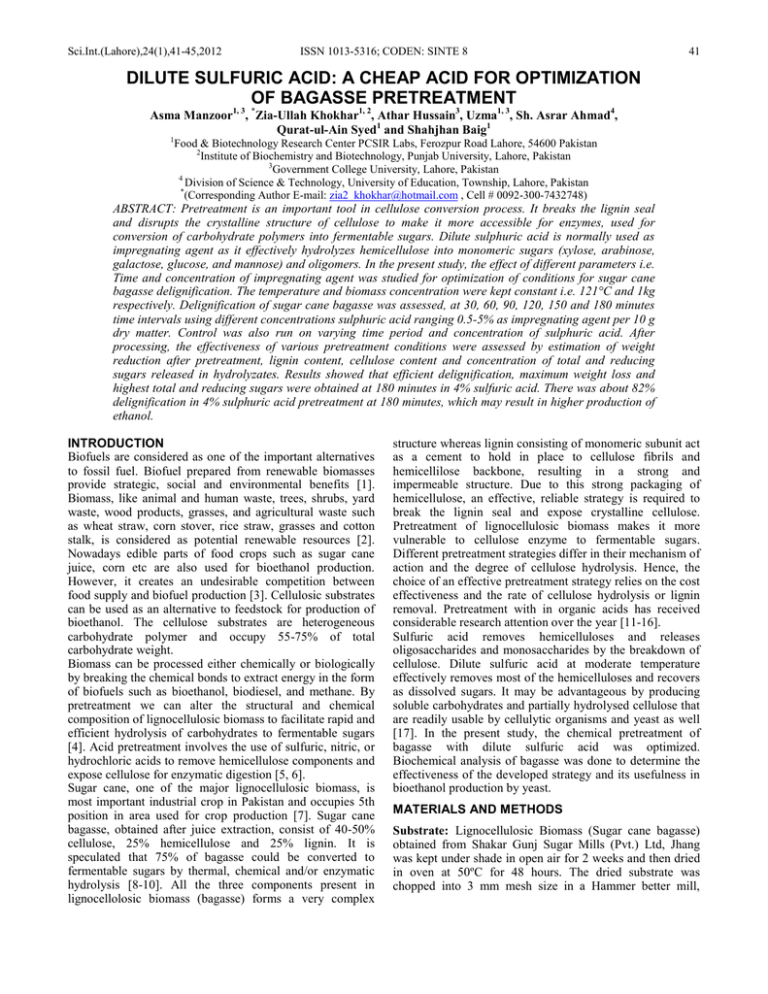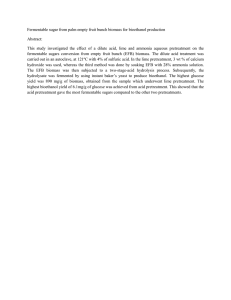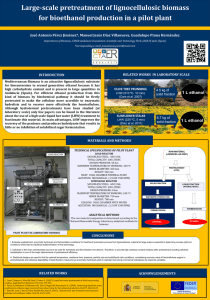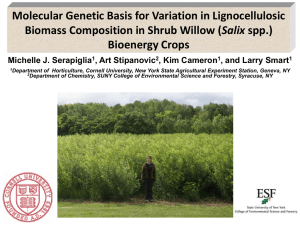Dilute Sulfuric Acid: A Cheap acid for Optimization of Bagasse
advertisement

Sci.Int.(Lahore),24(1),41-45,2012 ISSN 1013-5316; CODEN: SINTE 8 41 DILUTE SULFURIC ACID: A CHEAP ACID FOR OPTIMIZATION OF BAGASSE PRETREATMENT Asma Manzoor1, 3, *Zia-Ullah Khokhar1, 2, Athar Hussain3, Uzma1, 3, Sh. Asrar Ahmad4, Qurat-ul-Ain Syed1 and Shahjhan Baig1 1 Food & Biotechnology Research Center PCSIR Labs, Ferozpur Road Lahore, 54600 Pakistan 2 Institute of Biochemistry and Biotechnology, Punjab University, Lahore, Pakistan 3 Government College University, Lahore, Pakistan 4 Division of Science & Technology, University of Education, Township, Lahore, Pakistan * (Corresponding Author E-mail: zia2_khokhar@hotmail.com , Cell # 0092-300-7432748) ABSTRACT: Pretreatment is an important tool in cellulose conversion process. It breaks the lignin seal and disrupts the crystalline structure of cellulose to make it more accessible for enzymes, used for conversion of carbohydrate polymers into fermentable sugars. Dilute sulphuric acid is normally used as impregnating agent as it effectively hydrolyzes hemicellulose into monomeric sugars (xylose, arabinose, galactose, glucose, and mannose) and oligomers. In the present study, the effect of different parameters i.e. Time and concentration of impregnating agent was studied for optimization of conditions for sugar cane bagasse delignification. The temperature and biomass concentration were kept constant i.e. 121°C and 1kg respectively. Delignification of sugar cane bagasse was assessed, at 30, 60, 90, 120, 150 and 180 minutes time intervals using different concentrations sulphuric acid ranging 0.5-5% as impregnating agent per 10 g dry matter. Control was also run on varying time period and concentration of sulphuric acid. After processing, the effectiveness of various pretreatment conditions were assessed by estimation of weight reduction after pretreatment, lignin content, cellulose content and concentration of total and reducing sugars released in hydrolyzates. Results showed that efficient delignification, maximum weight loss and highest total and reducing sugars were obtained at 180 minutes in 4% sulfuric acid. There was about 82% delignification in 4% sulphuric acid pretreatment at 180 minutes, which may result in higher production of ethanol. INTRODUCTION Biofuels are considered as one of the important alternatives to fossil fuel. Biofuel prepared from renewable biomasses provide strategic, social and environmental benefits [1]. Biomass, like animal and human waste, trees, shrubs, yard waste, wood products, grasses, and agricultural waste such as wheat straw, corn stover, rice straw, grasses and cotton stalk, is considered as potential renewable resources [2]. Nowadays edible parts of food crops such as sugar cane juice, corn etc are also used for bioethanol production. However, it creates an undesirable competition between food supply and biofuel production [3]. Cellulosic substrates can be used as an alternative to feedstock for production of bioethanol. The cellulose substrates are heterogeneous carbohydrate polymer and occupy 55-75% of total carbohydrate weight. Biomass can be processed either chemically or biologically by breaking the chemical bonds to extract energy in the form of biofuels such as bioethanol, biodiesel, and methane. By pretreatment we can alter the structural and chemical composition of lignocellulosic biomass to facilitate rapid and efficient hydrolysis of carbohydrates to fermentable sugars [4]. Acid pretreatment involves the use of sulfuric, nitric, or hydrochloric acids to remove hemicellulose components and expose cellulose for enzymatic digestion [5, 6]. Sugar cane, one of the major lignocellulosic biomass, is most important industrial crop in Pakistan and occupies 5th position in area used for crop production [7]. Sugar cane bagasse, obtained after juice extraction, consist of 40-50% cellulose, 25% hemicellulose and 25% lignin. It is speculated that 75% of bagasse could be converted to fermentable sugars by thermal, chemical and/or enzymatic hydrolysis [8-10]. All the three components present in lignocellolosic biomass (bagasse) forms a very complex structure whereas lignin consisting of monomeric subunit act as a cement to hold in place to cellulose fibrils and hemicellilose backbone, resulting in a strong and impermeable structure. Due to this strong packaging of hemicellulose, an effective, reliable strategy is required to break the lignin seal and expose crystalline cellulose. Pretreatment of lignocellulosic biomass makes it more vulnerable to cellulose enzyme to fermentable sugars. Different pretreatment strategies differ in their mechanism of action and the degree of cellulose hydrolysis. Hence, the choice of an effective pretreatment strategy relies on the cost effectiveness and the rate of cellulose hydrolysis or lignin removal. Pretreatment with in organic acids has received considerable research attention over the year [11-16]. Sulfuric acid removes hemicelluloses and releases oligosaccharides and monosaccharides by the breakdown of cellulose. Dilute sulfuric acid at moderate temperature effectively removes most of the hemicelluloses and recovers as dissolved sugars. It may be advantageous by producing soluble carbohydrates and partially hydrolysed cellulose that are readily usable by cellulytic organisms and yeast as well [17]. In the present study, the chemical pretreatment of bagasse with dilute sulfuric acid was optimized. Biochemical analysis of bagasse was done to determine the effectiveness of the developed strategy and its usefulness in bioethanol production by yeast. MATERIALS AND METHODS Substrate: Lignocellulosic Biomass (Sugar cane bagasse) obtained from Shakar Gunj Sugar Mills (Pvt.) Ltd, Jhang was kept under shade in open air for 2 weeks and then dried in oven at 50ºC for 48 hours. The dried substrate was chopped into 3 mm mesh size in a Hammer better mill, 42 ISSN 1013-5316; CODEN: SINTE 8 pulverized and then washes in hot water to remove residual sugars [18]. Preparation of Bagasse for Pretreatment: The dry sugar cane bagasse was weighed to 4kg and stored at room temperature. 10 g of baggase were added in the individual flasks and soaked in 0.5-5% sulfuric acid solution in duplicate to submerge the sugar cane residue and allowed to soak for 24 hours. After soaking, the mixture was filtered. The residue was rinsed with distilled water for 30 minutes thrice. The residue was oven dried at 100-105ºC and stored for further chemical hydrolysis. Chemical Pretreatment of Bagasse: The bagasse was pretreated with various concentrations of sulphuric acid at different time intervals (0 to 3 hrs), keeping the temperature and mass of bagasse constant. 10 gm of Bagasse was taken in separate conical flasks and different concentrations of sulphuric acid (0.5%, 1%, 1.5%, 2%, 2.5%, 3%, 3.5%, 4%, 4.5%, and 5%) were added. Bagasse was autoclaved at 121 ºC at 30 minute, 1hr, 1.5hr, 2hr, 2.5hr and 3hrs intervals. Autoclaved samples were filtered and pure hydrolyzate was stored at 4ºC for analysis of sugar contents. The remaining residue was washed till neutral pH and oven dried at 100105ºC. This solid residue was kept for biochemical analysis. Hydrolysates for fermentation were prepared by taking 500gm of each dry milled lignocellulosic biomass, mixed with 5M sulphuric acid solution and kept in the digester for one hour for both concentrations. After required intervals of time, water was added in the Erlenmeyer flasks for dilution of acid and by filtration digested samples were recovered and washed with distilled water til the neutral pH. Then dried at 60◦C overnight using the method described by Fan et al [19] and [20]. The dried hydrolysate was stored in sterile polypropylene bags for further use. Weight Loss of Bagasse after Pretreatment: Sugar cane bagasse was treated with different concentrations of Sulphuric acid 0.5-5% at different time interval 30-180 mins respectively, then autoclaved at 121ºC, filtered it, washed till the pH was neutral and dried in an oven at 100-105ºC for over night finally the weight of bagasse was reduce after pretreatment was measured by using electric balance. Sci.Int.(Lahore),24(1),41-45,2012 [22]. The total sugar concentrations were measured by using spectrophotometer at 470 nm. Reducing Sugars Analysis: reducing sugars in un-treated and treated raw material were measured by DNS method using glucose as a standard [23]. Statistical Analysis: Analysis of variance (ANOVA) was applied. Statistical significance was adjusted at p < 0.05. Analysis was done by using SPSS. RESULTS AND DISCUSSION In the present study, biochemical analysis of sugar cane bagasse after acid pretreatments was done to achieve maximum delignification which results in digestion of biomass sample and production of fermentable sugars and ethanol production. Lignin is a factor affecting the enzymatic hydrolysis of biomass. Hence, removal of lignin lowers the enzyme requirement [24]. Lignocellulosic biomass can not be saccharified by enzyme to high yields without pretreatment, mainly because of the lignin in plant cell wall forms a barrier against enzymatic attack [25]. An ideal chemical pretreatment would reduce the lignin contents, crystallinity of cellulose and increased the surface area [26] and separation of the structural linkage between lignin and carbohydrate, increasing hydrolysis of cellulose. Pretreatment is however, crucial for ensuring good ultimate yield of sugars from both polysaccharides i.e. cellulose and hemicellulose of the biomass. It has been seen that enzymatic hydrolysis without pretreatment yield less than 20% while pretreatment rises sugar yield over 90% [27]. The biodegradability of lignocellulosic biomass is limited by several factors like crystallinity of cellulose, available surface area, and lignin content [28]. Dilute sulphuric acid used as a catalyst for hemicellulose and lignin solubilization at low concentration (0.05%-5%). The acid treatment minimized the formation of degradation products and maximize sugars yield at the end of the process [29]. BIOCHEMICAL AND ANALYTICAL ANALYSIS Determination of lignin: Van Soest and Wine [21] procedure was applied for the determination of lignin content. The % lignin was determined by using formula: (Wt. of digested material) – (Wt. of ash) % lignin = X 100 Weight of sample taken Determination of Cellulose: Cellulose content was determined by using standard procedure demonstrated by Van soest and Wine [21]. The % cellulose was determined by using formula: (Wt. of digested material) – (Wt. of ash) % cellulose = X 100 Weight of sample taken Total sugar Analysis: The carbohydrate/sugar contents of un-treated and pretreated raw materials were measured using Phenol Sulphuric acid method just as Pettersson and Porath Fig 1 Weight loss (gms) of baggase at different concentrations of sulphuric acid treatment for 30 min (closed square), 60 min (open square), 90 min (closed circle), 120 min (open circle), 150 min (closed triangle) and 180 min (open triangle). Sci.Int.(Lahore),24(1),41-45,2012 ISSN 1013-5316; CODEN: SINTE 8 Fig 2 Lignin (%) of baggase at different concentrations of sulphuric acid treatment for 30 min (closed square), 60 min (open square), 90 min (closed circle), 120 min (open circle), 150 min (closed triangle) and 180 min (open triangle). Fig 3 Delignification (%) of baggase at different concentrations of sulphuric acid treatment for 30 min (closed square), 60 min (open square), 90 min (closed circle), 120 min (open circle), 150 min (closed triangle) and 180 min (open triangle). Fig 4. Cellulose (%) of baggase at different concentrations of sulphuric acid treatment for 30 min (closed square), 60 min (open square), 90 min (closed circle), 120 min (open circle), 150 min (closed triangle) and 180 min (open triangle). 43 Fig 5 Total sugars (%) of baggase at different concentrations of sulphuric acid treatment for 30 min (closed square), 60 min (Open Square), 90 min (closed circle), 120 min (open circle), 150 min (closed triangle) and 180 min (open triangle). Fig 6 Reducing sugar (%) of baggase at different concentrations of sulphuric acid treatment for 30 min (closed square), 60 min (Open Square), 90 min (closed circle), 120 min (open circle), 150 min (closed triangle) and 180 min (open triangle) Weight loss: The maximum weight loss of bagasse (47.7%) occurred on 4% sulfuric acid at 121ºC for 180 minutes (Fig 1). The finding is in agreement with previous study, which reported that the amount of weight loss of chemical pretreatment of lignocellulosic residue was due to lignin removal [30]. Furthermore, greater weight loss indicates more lignin loss and cellulose digestibility. Lignin: Fig 2 shows that 4.4% lignin remained in the biomass, when bagasse was pretreated with 4% of sulfuric acid at 121ºC for 180min. The previous study showed that 20% lignin remained in bagasse when it was treated for 15 min with 10% sulfuric acid at 121ºC [17]. The present study shows that maximal lignin can be removed by treating sugar cane baggase in lower concentrations of sulphuric acid for longer period of time. The present pretreatment conditions are more economical and can be used at commercial scale. Delignification: The maximum delignification was 82% at 121ºC on 4% of sulfuric acid for 180 minutes as shown in Fig 3. Rocha et al., [31] demonstrated that when bagasse is pretreated in sulfuric acid for production of bleached pulp. There is about 99.6% delignification, in the processing of 44 ISSN 1013-5316; CODEN: SINTE 8 crude pulp to bleached pulp. Our results are better than Khokhar et al [26] who reported 74% delignification of wheat straw with 1.5% sulphuric acid for 75 mints at 121ºC and 15 lb pressure while maximum weight loss was 49.9%. Our result is also better than Irfan M. et al (2010) who reported 81% delignification of bagasse with 3.5 % Sodium Sulphite [34]. Cellulose: The present study indicates that digestibility of cellulose increased by increasing the treatment time at a particular concentration Fig 4. 12.08% cellulose was remained in the bagasse residue after treating with 4% sulfuric acid at 121ºC for 180 min. Two grass species creeping wild rye and jose tall wheatgrass in 1.4% w/w dilute sulphuric acid 165°C 8 min loss 59 % jose tall wheatgrass, cellulose hydrolysis 9-12% [32]. 0.5-1 % sulphuric acid at 140-190 °C effectively removes and recovers most of the hemicellulose to almost 100 % [33]. However, contrary to our findings, Han and Callihan [17] reported that the digestibility of cellulose was maximum when the bagasse was treated for 15 min with 50% of sulfuric acid at 121ºC, followed by dilution of acid to 1% and heating for 1h, at 121ºC. About 20% of cellulose was remained in the sugar cane bagasse. Total sugar:In this study, the bagasse treatment with 3.5% Sulphuric acid at 121ºC for 180 minutes resulted in production of 265.04 mg/ml of total sugars Fig 5. Previous study has reported that the total sugar production was maximum (23%), when the bagasse was treated for 15 min with 50% sulfuric acid at 121ºC, followed by dilution of acid to 1% and heating for 15 min at 121ºC [17]. The present study demonstrates that the decreased sulphuric acid concentrations increases total sugar production. The data further suggest that 3.5% sulphuric acid not only increases total sugar release but also reduces the economic cost needed for biofuel production through wastes. Reducing sugar: The bagasse treated with 2.5% Sulphuric acid at 121ºC for 180 minutes resulted in production of 85.96 mg/ml of reducing sugars (Fig 6). Han and Callihan [17] reported maximum production (19.2%) of reducing sugar when the bagasse was treated for 15 min with 50% of sulfuric acid at 121ºC, followed by dilution of acid to 1% and heating for 2 h, at 121ºC. Khokhar et al (2010) pretreated wheat straw with 1.5% sulphuric acid for 75 mints at 121ºC and 15 lb pressure and reported that maximum total phenols 10.89 mg/ml, reducing sugars 42.99 mg/ml and total sugars 65.34 mg/ml [25-26]. the industrial processing of bioresources may produce raw materials for bioethanol production. The biofuels produced through biotechnological processes can be the excellent alternative to fossil fuels and hence decrease air pollution and save a lot of foreign exchange which is need of the day. ACKNOWLEDGMENTS Authors are thankful to the Ministry of Science and Technology (MoST) and Higher Education Commission (HEC), Govt. of Pakistan. Authers are also thankful to laboratory staff for their helping co-operation. REFERENCES 1. 2. 3. 4. 5. 6. 7. 8. 9. 10. 11. CONCLUSION The present study demonstrates that a more effective and economical delignification of biomass can be done in acidic medium. Chemical pretreatment is most advanced and effective way because it decreases the cellulose crystallinity, increases accessible surface area for enzymes and removal of lignin from lignocellulosic biomass and ethanol production is higher. The best results of delignification were obtained using 4% sulfuric acid at 121ºC for 180 minutes. Under these pretreatment conditions 82% delignification occurred, which may result in higher ethanol production. We achieved our objectives successfully. Further research is needed to optimize the conditions for maximum production of ethanol. As the lignocellulosic by-product derived from Sci.Int.(Lahore),24(1),41-45,2012 12. 13. 14. Lynd L. R., Cushman H. J., Nichols J. R., and Wyman E. E., Fuel ethanol from cellulosic biomass Science, 251: 13181323 (1999). McKendry, P., Energy production from biomass (part 1): overview of biomass. Bioresour. Technol., 83: 37–46(2002). Gray, K. A., L. Zhao and M. Emptage, Bioethanol: Current Opinion in Chemical Biotechnology, 10: 141-146 (2006). Chang, V. and M. Holtzapple,. Fundamental factors affecting biomass enzymatic reactivity. Appl. Biochem. Biotechnol, 537, 84–86, (2000). Schell, D. J., Former J., Newman M., Mcmillan J. D., DiluteSulfuric acid pretreatment of corn Stover in pilot scale reactor. Appl. Biochem. Biotechnol., 86. 105-108. (2003) Silverstein, A. Rebecca, Y. Chen, R. Sharma-Shivappa, M. D. Boyette and J. Osborne, A comparisons of chemical pretreatment methods for improving saccharification of cotton stalks. Bioresour. Technol, 98: 3000–3011 (2007) Khan, M. A., H. K. Keerio, S. Junejo, R. N. Panhawar, M. A. Rajput, Y.M. Memon and B. R. Qazi, Evaluation of new sugarcane genotype developed through fuzz. Correlation of cane yield and yield components. Pak. J. Appl. Sci. 3(4): 270273 (2003) Beguin, P. and J. P. Aubert, The biological degradation of cellulose. FEMS Microbiol. Rev., 13: 25-58(1994). Neureiter, M., H. Danner, C. Thomasser, B. Saidi and R. Braun, Dilute-acid hydrolysis of sugarcane bagasse at varying conditions. Appl. Biochem. Biotechnol. 98: 49-58 (2002). Martin, C., M. Galbe, C. Wahlbom, H. B. Hagerdal and L. Jonson, Ethanol production from enzymatic hydrolysates of sugarcane bagasse using recombinant xylose-utilizing Saccharomyces cervisiae. Enz. Microbiol. Technol., 31 (3): 274-282 (2002). Tsao, G. T., M. R. Ladisch, M. Voloch and P. Bienkowski. Production of ethanol and chemicals from cellulosic materials. Process Biochem. 17 (5): 34-35 (1982). Bienkowski, P., M. R. Ladisch, M. Voloch and G. T. Tsao,. Acid hydrolysis of pretreated lignocellulose from corn residue. Biotechnol. Bioengineer. Symposium Series, 14: 512-524 (1984). McMillan, J. D., Pretreating Lignocellulosic Biomass: A Review. In Enzymatic Conversion of Biomassfor Fuels Production. Himmel ME, JO Baker and RP Overend,ACS Symp. Ser 566. Washington DC. American Chemical Society, chapter 15, 292-324(1994). Hsu, T. A., Pretreatment of Biomass, In Wyman CE (ED) Handbook on Bioethanol, Production and utilization. Taylor & Francis, Washington DC. (1996) Sci.Int.(Lahore),24(1),41-45,2012 ISSN 1013-5316; CODEN: SINTE 8 15. Jacobsen, S. E. and C. E. Wyman,. Hemicellulose and cellulose hydrolysis models for application to current and novel pretreatment process. Appl. Biochem. Biotechnol., 84(86): 81-96 (1999). 16. Lee, Y. Y., P. Lyer and R. W. Torget,. Dilute-acid hydrolysis of lignocellulosic biomass. Adv. Biochem Engineer. Biotechnol., 65: 93. (1999) 17. Han, Y. W. and C. D. Callihan,. Cellulose fermentation: Effect of substrate pretreatment on microbial growth. Appl. Microbiol. 27 (1): 159-165 (1974). 18. Rezende, M. I., A. D. M. Barbosa, A. F. D. Vasconceios and A. S. Endo,. Xylanase production by Trichoderma Harzianum Rifai by Solid State Fermentation on Sugar cane Bagasse. Brazilin J. Microbiol., 33: 67-72 (2002). 19. Fan, L. T., Y. Lee and D. H. Beardmore, Mechanism of the enzymatic hydrolysis of cellulose: Effects of major structural features of cellulose on enzymatic hydrolysis. Biotechnol Bioengineer, 22: 177-199(1980). 20. Rajoka, M. I. and K. A. Malik, Cellulase production by Cellulomonas biazotea cultured in media containing different cellulosic substrates. Bioresourse Technology, 59: 2127(1997). 21. Von Soest, P. J. and R. H. Wine, Use of detergents in the analysis of fibrous feed. Iv. Determination of plant cell-wall constituent’s journal. Association of Analytical chemistry, 50: 50-55 (1967). 22. Petterson, G. and J. Porath,. A cellulytic enzyme from penicillium notatum,. IN S.P. Colwick and N. O.Kaplan (ed). Methods in enzymology, Academic Press Inc, New York. 8, 603-607 (1966) 23. Montgomery, R., Further studies of the phenol sulfuric acid reagent for carbohydrates. Biochemistry-Biophysics, Acta 48-591(1961). 24. Mooney, C. A., S. D. Mansfield, M. G. Touhy and J. N. Saddler,. The effect of initial pore volume and lignin content on the enzymatic hydrolysis of soft woods. Bioresour Technol., 64: 113-119 (1998). 45 25. Khokhar U. Z., Syed Q., Baig S., Nadeem M., Irfan M. and Athar A. M., Study on Filtrate Obtained from Batch-Wise Pretreatment of Wheat Straw at Different Concentrations of H2 SO4 and Autoclave Time, World Appl. Sci. J., 10 (9): 1047-1055 (2010). 26. Khokhar U. Z., Syed Q., Nadeem M., Baig S., Irfan M., Gull I., Tipu I. Aslam S., Samra Q. Z. and Athar A. M., Delignification Of Wheat Straw With Acid And Hydro-steam Under Pressure, World Appl. Sci. J., 11 (12): 15241530(2010). 27. Hamelinck, C. N., G. V. Hooijdonk and A. Faaij, ‘Cradle-tograve’ assessment of existing lignocellulose pretreatment technologies. J. Biomass and Bioenergy, 28: 384-388 (2005) 28. Schmidt, A. S. and A. B. Thomsen,. Optimization of wet oxidation pretreatment of wheatstraw. J. Bioresour Technol., 64: 139-151(1998). 29. Lloyd, T. A. and C. E. Wyman, Combined sugar yields for dilute sulfuric acid pretreatment of corn stover followed by enzymatic hydrolysis of the remaining solids. Bioresour. Technol., 96: 1967–1977 (2005). 30. Wyman, C. E., Handbook on bioethanol: production and utilization; Taylor & Francis: Washington DC, USA (1996). 31. Rocha, G. J. M., N. K. Balczo, C. Vacaro and R. C. L. B. Rodrigues, Obtainment and characterization of cellulose from sugarcane bagasse pretreated in acid medium for the synthesis of Hydroxypropylmethyl cellulose (HPMC). Ibero American Congress on pulp and paper research. (2002) 32. Zheng, Y., P. Zhongli, R. Zhang, J. M. Labavitch, D. Wang, S. A. Teter and B. M. Jenkins,. Evaluation of different biomass materials as feedstock for fermentable sugar production. Journal of applied biochemistry and biotechnology, 136-140 (2007). 33. Knappert H, H Grethlein and A Conversa, Partial acid hydrolysis of popular wood as a pretreatment for enzymatic hydrolysis, Bioengineering Symposium 11: 67-77 (1981). 34. Irfan M., Abbas S., Baig S., Gulsher M., Nadeem M., Syed Q. 2010. Pretreatment: A potential technique to enhance the enzymatic hydrolysis. Word J. Agri. Sci. 6 (4): 440-445. .


